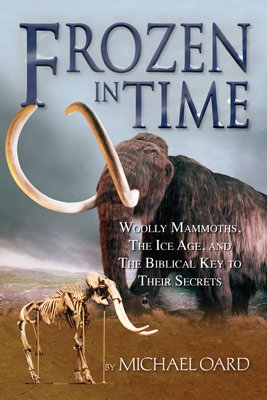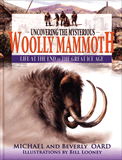
Chapter 16
Extinction of the Woolly Mammoth
Climate change at the end of the Ice Age was the main cause of late Ice Age extinctions.
Millions of woolly mammoths roamed the grassy steppes of Siberia, Alaska, and the Yukon by the middle of the Ice Age. They also spread into Europe and southern North America. Then suddenly, at the end of the Ice Age, they all disappeared. Dozens of other large mammals and birds also disappeared from continents or the whole earth. Why? I will focus mainly on Siberia and then discuss end-Ice Age extinctions in other parts of the world.
How did the woolly mammoth die in Siberia?
Many of the Siberian mammals likely died from the cold, wind, and drought that came during the deglaciation phase.1 Only the most hardy and resourceful animals could survive for long. It is possible that the mammoth’s woolly coat and plenty of dried grass gave them enough warmth and calories that they were able to slake their thirst by eating snow. Most of the available water was frozen. I tend to think that only the largest mammoths would have enough body mass to make this work. It helps a little that the woolly mammoths were able to handle some cold.
There is a question about how cold-adapted the woolly mammoths actually were, since a few scientists have claimed the mammoths lacked oil glands in their skin that would repel the water on their woolly coat. A wet woolly coat would be a powerful cooling mechanism to the animal. However, Russian scientists have shown that the woolly mammoth did possess oil glands to waterproof its wool.2 The woolly mammoth did posses other features that are adaptations to a cold climate, such as long hair, small ears, a small tail, and a flap of skin over its anus. So, the woolly mammoth likely could take more cold than most other animals.
It is true that the climate tolerance of some animals is high. Horses live today in central Siberia, but ranchers help them to survive the winter. The reintroduced musk ox lives as far north as the northern Taimyr Peninsula and Wrangel Island, northern Siberia, which is a little warmer in winter than interior Siberia. But, there are limits to cold tolerance, even for the woolly mammoth. During the deglaciation period, the Siberian winter temperatures probably dropped about 20°F (12°C) colder than today. This bone-chilling cold would have even stressed animals that were well dressed for it.
Cold, wind, flooding, and drought can account for many of the mammoth deaths, but there is still the question as to how most of them became interred in the permafrost. There are several possibilities. The most-mentioned possibility is that the mammoths were trapped in bogs. Some undoubtedly were trapped in bogs.3 The position of the Selerikan horse suggests entrapment in a bog to Guthrie.4 Bogs would have been caused by the summer melting of the permafrost. When the top foot or two (about half a meter) of permafrost melts in the summer, the water would pool since the permafrost below remains frozen. The large animals inexperienced with bogs could possibly have fallen into one. However, a bog may form year after year, and the animal trapped in the bog may never end up in the permafrost below the bog. Furthermore, large animals likely are strong enough to pull themselves out of a shallow bog.5 Since the bogs of Siberia would be shallow, a trapped mammoth would very likely not suffocate and end up in a standing position. Moreover, if the Siberian mammoths commonly died in bogs, there should be evidence in the form of peat or bog vegetation surrounding the bones. However, it seems that the vast majority of mammal remains are not surrounded by peat or bog vegetation.
During deglaciation, some of the animals would have been trapped by flooding rivers. Those that were trapped would have ended up in river terraces or flood plains that would be incorporated into the permafrost. Some animals lie buried in river deltas where they emptied into the Arctic Ocean. Ukraintseva6 provides evidence that the Khatanga and Shandrin mammoth carcasses were buried fluvially. Currently, there is evidence of catastrophic flooding in the upper Ob River basin of western Siberia on the scale of the glacial Lake Missoula flood.7 The Ob River flood originated from a burst proglacial lake from the Altai Mountains of southwest Siberia.8 Some animals surely must have been buried in this gigantic flood. The Berelekh mammoth cemetery in north-central Siberia contains the remains of more than 156 woolly mammoths and a few other types of animals. The cemetery is very likely a fluvial concentration, possibly a post-Ice Age lag from mammoths washed out of the nearby permafrost hills.9
Some mammoths appear to have perished in lakes.10 Abundant shorelines up to and around 300 feet (90 m) above sea level11 indicate there was a ponded Ice Age lake in the middle and lower reaches of the Ob River valley of western Siberia.
I believe the key to the majority of the well-preserved bones, tusks, and carcasses in the permafrost can be found in the type of sediment surrounding the woolly mammoths.
Mammoths mostly buried in wind-blown silt
According to those who have studied the deposits that contain most of the mammoth remains in Siberia, the vast majority of the animals are found in what are called “yedomas” (or “edomas”).12 The yedomas, a Yakut name, are hills with a high proportion of ground ice. They generally stand about 30–60 feet (10 to 20 m) high, but sometimes up to 200 feet (60 m) high.13 In Alaska, the material is called “muck”.14 Muck is organic-rich deposits named by gold miners for the material above auriferous gravels in Alaska and the Yukon.15 Vereshchagin16 states that the yedomas contain a great profusion of mammal bones:
The great abundance of bones of large herbivores in the Yedoma is convincing evidence of the rich pasturage offered by this region during the Pleistocene . . . .
Tomirdiaro17 also states that there is a large number of mammoth, horse, bison, and even saiga antelope bones in yedomas. Hamilton, Craig, and Sellmann18 write in regard to the muck of Alaska that is commonly found in the bottom of valleys:
Bones of large, extinct vertebrates, such as bison and mammoth, are common in the valley-bottom deposits, which generally contain abundant plant and animal remains.
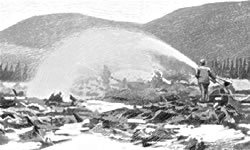
Figure 16.1. Gold miners washing out muck (reworked loess) to find gold in the gravel below.
What type of sediment makes up the yedomas and muck? There has been a great deal of controversy and a number of hypotheses on the origin of yedomas and muck. Until fairly recently, the Siberian plains were considered regions of alluvial or lacustrine deposition.19 Now it is accepted that the yedomas and muck are composed of loess.20 Loess is wind-blown silt mixed with a little clay and fine sand (figure 16.1). Vereshchagin and Tomirdiaro21 state:
Of particular interest for paleozoologists is the “edoma.” . . . This is actually a loess layer, as a rule containing the largest amount of remains of Late Pleistocene animals.
Guthrie22 reinforces this observation:
Like most of the Soviet Far East, large expanses of Alaska and the Yukon Territory were not glaciated during the Pleistocene. Because these areas were bounded on several sides by enormous glaciers and glacial outwash streams, today much of Beringia [eastern Siberia, Alaska and the Yukon] is mantled with a thick deposit of eolian (wind-blown) silt called loess . . . .
So, the vast majority of Ice Age animals are buried in wind-blown silt.
There is much support for a wind-blown origin for the sediments in yedomas. The lack of channels or channel deposits in the yedomas and vertical roots of herbaceous plants that often penetrate the entire thickness of the yedoma rules out a fluvial or lacustrine origin.23 Loess in north-central Siberia is about 30 to 115 feet (10 to 35 m) thick, but around 160 feet (50 m) thick near the Lena and Aldan Rivers of central Siberia.24 Loess is thickest near the rivers and thins in the uplands, typical of loess deposits elsewhere.25 Arkhipov26 states:
In eastern Siberia the aeolian loess cover containing ice veins is called “edoma” (loess-ice formation; Tomirdiaro, 1980; Bolikhovsky, 1987). The windblown sediments locally reach significant thicknesses (15–20 m) [45–65 ft.] and cover marine sediments of terraces III and alluvial deposits of terrace II. Similar loess deposits occur south of the permafrost zone (south of 60°N) in the inner regions of Siberia.
Alaskan and Siberian loess is similar.27 Stephen Taber28 says that the thickness of the silt in Alaska varies from a few inches to over 200 feet (60 m), but in some river valleys it is considerably thicker, probably due to downslope mass transport.29 In unglaciated Alaska, the loess is as thin as an inch on the upper slopes, about 65 feet (20 m) thick on middle slopes, and as much as 115 feet (35 m) or more thick in the valley bottoms.30 At least some of the loess apparently was deposited from unglaciated river valleys that were choked full of glacial silt during deglaciation. Today, loess is deposited downwind from braided rivers that drain glaciers.31
However, there does not seem to be enough sources for the abundant loess in Siberia and Alaska. Besides glacial outwash deposits in river valleys, another possible source for loess is the wide, exposed continental shelves, at least until the shelves were flooded late in the deglaciation phase. The loess closest to the coast has a high salt content, giving credence to this prospect.32 It is also possible that much mud was left on the land after the Genesis flood receded. This mud could have been reworked into wind-blown deposits at the end of the Ice Age.
The loess in Siberia has a fairly high organic content. It is composed of buried vegetation and peat layers, as well as animals.33 Some trees were buried in loess and remain in situ as stumps,34 while other trees and vegetation have slid downslope forming reworked loess, particularly in Alaska. Fraser and Burn35 state in regard to the peat layers within the loess:
Numerous peat beds are horizontally continuous, with some containing tree stumps in growth position. Retransportation of some organic material is suggested by the unsorted nature of several portions of the unit. Commonly, such organic material is twisted and broken and has random orientations.
This reworked loess that slid down hills in Alaska is what is called muck. The twisted, broken, and randomly orientated vegetation in the Alaskan muck probably is responsible for some of the exaggerations of some writers, such as Velikovsky. Upon thawing, the decaying vegetation in the loess gives off a stench.
How did ice develop in the loess?
The loess is rich in ground ice and ice wedges (see figure 16.2). The ground ice most likely developed within the silt through a segregation process in which layers of ice and ice lenses formed.36 Silt has a porosity of greater than 50 percent,37 so silt is especially favorable for the formation of ground ice. Water flows too slowly in clay and too fast in sand for significant ice lenses and wedges to form. With silt, the water flow would be absorbed at the right pace to freeze against a barrier and build layers and lenses, as well as ice wedges. Walker and Everett38 describe segregated ice in modern loess near Prudhoe Bay:
Silty deposits can develop large volumes of segregated ice, largely due to the platey structure common to these wind-blown deposits. Interstitial water moves by capillary action along moisture tension gradients to freeze into lens-shaped bodies of segregated ice ranging in thickness from a few millimetres to several metres . . . . Segregations of nearly pure ice in 1 m thick loess at Prudhoe Bay can account for between 10 and 70% of a given volume.
The amount of segregated ice in Siberian loess can be quite large, up to 90 percent, with vertical ice veins about 30 feet (10 m) wide.39 Usually, the average amount of ice in the muck of Alaska is more like 50 percent.40 Segregated ice is believed to have formed at the same time as the loess was deposited as a result of summer precipitation.41 The timing within the uniformitarian paradigm is late in the last glacial period. They judge the climate as being colder than it is today based on C-14 dating and oxygen isotope ratios.42
It is likely the segregated ice and ice wedges gave vent to the myth that the mammoths are encased in ice. Otto Herz, one of the excavators of the Beresovka mammoth, was convinced that the animal had fallen into a crevasse within an ice sheet. The mammoths are entombed in silt, not ice,43 although segregated ice and ice wedges commonly surround their bones and carcasses.

Figure 16.2 The development and enlargement of an ice wedge, if ice is still present, or an ice wedge cast, if the ice is melted.
How does the post-Flood Ice Age explain the animals buried in loess?
As the climate cooled and dried, the animals likely were forced to move north to the warmer coastal regions where it was warmer in the winter. The Arctic coast was warmer because the ocean had not yet frozen over. This is because saltwater is difficult to freeze. Once deglaciation was well underway, fresh meltwater from the ice sheets and mountain ice caps poured over the denser saltwater. This started the rapid formation of sea ice. Sea ice would reinforce atmospheric cooling and drying by reflecting more sunlight to space and decreasing oceanic evaporation from the Arctic Ocean. As more of the ocean surface froze, the atmosphere would cool more, producing even more sea ice, just like a chain reaction. The amount of water poured out over the Arctic Ocean during deglaciation would have been huge, since these rivers today are quite large. In fact, 10 percent of all water discharged from continental rivers into the oceans today occurs in the Arctic Ocean.44 During deglaciation, much more water than today would have poured out into the Arctic Ocean and frozen due to all the meltwater from mountain ice caps. The formation of sea ice over the entire Arctic Ocean could have probably taken only a few years. The freezing would be enhanced by a significantly smaller ocean early in deglaciation. At glacial maximum, the very wide continental shelf off Siberia and Alaska was not covered by water.
By the end of deglaciation, the coast would have been inhospitable. The weather had become so cold and dry that many animals had to either flee or die. The mammoths, being less able to travel long distances over the developing permafrost and snow, were unable to make it out of Siberia. Since most of the continental shelf was exposed early in deglaciation, animals would be able to herd to the relatively high points of the New Siberian Islands. At this time, these islands were connected to the mainland. Deglaciation would have been fast, even catastrophic. Sea level would have risen, sometimes catastrophically. It is likely that the large amount of animals on the Arctic continental shelf took refuge on the New Siberian Islands during rising sea level. They were eventually cut off from the mainland with little food. Massive amounts of mammoth bones are found on these islands as well as the coastal areas.
In the post-Flood Ice Age model, strong winds would have characterized deglaciation, especially during winter and spring.45 Synoptic or large-scale wind is generally proportional to the subtropical-to-polar temperature difference, using the thermal wind equation.46 Since the polar latitudes were much colder, the mid-latitude westerly winds and the polar northeasterly winds would have been significantly stronger than today. In a dry environment, this would have caused an extraordinary amount of blowing silt and local sand. (Clay can be difficult to pick up by the wind, since it often forms a crust.) Large quantities of wind-blown material are observed as relic features of the Ice Age in many areas of the Northern Hemisphere and in the Ice Age portion of the Greenland and Antarctica ice cores. An extraordinary amount of blowing silt would be deposited from the combination of strong winds, dry climate, glacial silt particles from outwash areas, and probably the exposed continental shelves. It is known that mammoths and other mammals are entombed in loess in other areas of the Northern Hemisphere.47 Table 16.1 is a summary of all the factors that would contribute to dry windy storms at the end of the Ice Age.
Table 16.1: Reasons for dry, windy dust storms at the end of the Ice Age
1) Colder winters
2) Colder ocean
3) More sea ice
4) Drier atmosphere
5) Stronger N-S temperature difference
The wind deposition of mineral-rich loess would also reinforce the diverse grassland environment and hold off bog vegetation for a time.48 It would cover the thickening permafrost and allow the surface to drain during the summer. The areas of loess deposition today in northern Alaska show a greater variety of plants and tend to inhibit bog vegetation.49,50 Blowing silt would make the winter snow dirty, reduce the albedo, and contribute to rapid spring melting. This quick melting has been observed along the edge of roads in the Alaskan taiga and tundra that are covered by dust deposition from the road.51 It is also possible that the existence of so many mammals in Siberia helped reinforce the grassland environment by trampling the bog vegetation.52 Plenty of grass would continue to keep the animals relatively healthy. However, the loess could hold off the bogs only for so long in a cooling climate. Eventually, the bogs would take over and the environment would change from a steppe to tundra. It is well known that in the wind-blown silts of Siberia, steppe vegetation occurs along with the mammal remains.53 This changing environment probably accounts for the finding of a mixture of steppe and tundra vegetation in the stomachs of some of the carcasses and for the mixed pollen assemblage in the sediments around the carcasses.54
After deglaciation, the summers and the winters became warmer (the post-glaciation climate could be what uniformitarian scientists call the Holocene hypsothermal). Deglaciation would account for the thawing that is widely recognized not only in Siberia and Alaska, but elsewhere south of the former ice sheets.55 It is well known that there are relic permafrost features, such as ice wedge casts, south of where the Laurentide and Scandinavian ice sheets once existed. The permafrost in Siberia and Alaska, according to Guthrie, has melted northward.56 Melting reveals why the yedomas are now hills. The top of the permafrost melted in spots forming hollows, called alases. They are thermokarst features,57 which Soffer58 believes were caused by the melting of the Scandinavian ice sheet, while Sher59 describes them as a catastrophic event after the Ice Age. Bones of mammals are concentrated at the bottom of the alases.60 This is known to occur during a thaw.
In Alaska, the situation would have been different because of the higher relief. Either while the loess was being deposited or during the great post-glacial thaw, much of the loess would have slid into the valleys and formed the “muck.”
Gigantic dust storms explain the carcass puzzles
How would dust storms explain the rare carcasses and the other carcass puzzles? As discussed in chapter 1, there are a number of puzzles associated with the carcasses that have precipitated a multitude of disputable conclusions. The carcass puzzles are: (1) some carcasses and skeletons found in a general standing position, (2) three woolly mammoths and two woolly rhinos suffocated, (3) millions of animals became entombed in rock hard permafrost, and (4) some mammals have broken bones. The strong, cold winds during deglaciation whipped up multiple dust storms that blew across Siberia. The dust storms varied in intensity throughout the deglaciation phase, but regardless, the dead mammals would have been buried fairly quickly. Quick burial explains the preservation of the many millions of bones and tusks of the woolly mammoths and other mammals, the third carcass puzzle.
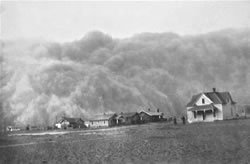
Figure 16.3. Approaching dust storm.
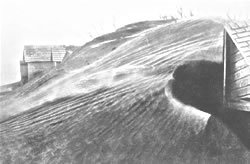
Figure 16.4. Large dust drift to the top of a house during the Dust Bowl era in the Midwest.
I believe the preservation of carcasses and the explanation of the other carcass puzzles can be explained by the most fierce dust storms. The Dust Bowl era in the Midwest United States in the 1930s provides an excellent analog for conditions in Siberia at the end of the Ice Age (figure 16.3). Many dust storms of variable intensity occurred during the Dust Bowl era. An intense dust storm can produced drifts many feet (a meter or more) high, just like drifts in a blizzard. During the Dust Bowl, several accumulating storms partially buried houses and barns and covered machinery and fences (figure 16.4). Some cattle caught in dust storms breathed in so much dust that they suffocated, and newborn calves smothered in a matter of hours.61
It is possible that the dust storms at the end of the Ice Age in Siberia were so intense that some woolly mammoths may have suffocated from blowing dust before they were buried. Another possibility is that silt would have been deposited around the animal caught out in the storm in much the same way blowing and drifting snow gathers against a snow fence. It is possible that a woolly mammoth could have been completely buried and suffocated in one gigantic dust storm. As a result, some of these animals could have been left in a general standing position, braced by the dust around them, as well as suffocated, which seems to be the case with the Beresovka mammoth.
Is there any proof from the carcasses that they died in dust storms? Other than the sediment surrounding the mammoths, there is little evidence from the carcasses, themselves. This lack of evidence is probably because the researchers have not looked for dust in the lungs area, or the evidence could have been obscured because of the surrounding loess. However, the baby mammoth, Dima, does provide possible evidence of suffocation in a dust storm. Guthrie62 states:
Mud in the gastrointestinal tract, silt in the respiratory system, and skeletal parts of Coleopteran beetles are incongruent with death in winter.
Although uniformitarian scientists are blind to the possibility of death during a dust storm, they do consider the observation of silt and mud within the carcass a puzzle.
Burial in loess would also account for how the animals were interred in the developing permafrost. An animal covered by silt could be frozen fairly quickly, if the dust storm were caused by a cold front. Once a carcass was covered, the freezing temperatures from the permafrost below would move upward and the cold air would cool the carcass from above. A carcass would not have to be forced downward into rock-hard permafrost, as Howorth thought, but the permafrost would have formed around it.
The preservation of the mammoths and other animals would vary, depending upon the exact conditions and speed of the process. The preserved carcasses could simply be those rare carcasses that were rapidly buried by the most fierce dust storms and frozen quickly enough to preserve the flesh and stomach contents. The cold would also slow decay by keeping bacteria counts low.63 Taber64 states:
Decomposition of organic matter is brought about almost entirely by bacteria which are relatively scarce in cold climates.
So the freezing of the carcasses could take several days and still leave the stomach contents only partially decayed.
Since the top foot or two (about half a meter) of the ground melted each year, a number of buried animals close to the surface would have thawed out and rotted, especially if the yearly deposit of loess was thin. This probably is what happened to the Shandrin mammoth, which is composed of bones and the stomach area but no muscle tissue. The muscle tissue could have thawed one or several times and decayed before the final burial in silt. Either because of thawing or by not being buried deep enough in loess, the vast majority of the animals would have decayed naturally, leaving only bones and tusks. Since bones and tusks are more durable, they could have undergone several freeze-thaw cycles before their final deep burial in loess. Since the number of cycles varied, the preservation of the tusks would vary as well. Predictably, the number of carcasses and the preservation of tusks increases northward.65
Burial in dust storms, instead of bogs, explains why the Selerikan horse was missing its head. Instead of having only its head exposed from a bog, as Guthrie surmises, the animal could have been buried in a dust storm with only its head showing. Then, a carnivore came and ate what was exposed. An analysis of the surrounding sediments and vegetation favors entrapment in wind-blown silt and not a bog.66
Time is not a side issue
Uniformitarian scientists do not recognize the significance of this wind-blown silt as a solution of the many mammoth mysteries. This is because they stretch the deposition of the loess over thousands of years bringing it to the point of insignificance. Guthrie67 states:
These [large bones] could not be preserved by a few millimeters of annual eolian loess-fall; their preservation required large quantities of reworked silt.
Vereshchagin68 corroborates with a much more generous, but still inadequate, annual loess deposition:
One important factor was the fall of loess on the cold wet ground. However, this deposition could hardly have exceeded 2–3 cm [one inch] a year and, at that rate, it would have taken 20–30 years to cover a mammoth, during which time the bones and tusks would have been almost entirely destroyed by atmospheric processes.
In the creation-Flood Ice Age model, the total loess deposition is compressed into a few hundred years or less, making loess deposition much more significant for the burial of mammoths. Time is not a side issue in creationist explanations for major mysteries of the past. I have often found that a short time scale is the key in providing reasonable solutions to long-standing mysteries of the past. Uniformitarian scientists will continue in their struggle to solve the riddles of the Ice Age and the woolly mammoths because of their dedication to present process over long ages.
The explanation for the broken bones
The fourth puzzle is the broken bones found in the Beresovka mammoth and the Selerikan horse.
The bones could easily have been broken by shifting of ground ice and frozen sediments, either during formation or afterward.69 In other words, the breaks could be a post-mortem effect caused by shifting permafrost. Vereshchagin and Tomirdiaro70 state:
After burial in the permafrost the organic remains could have shifted vertically within a wide range owing to their physical properties and the features of the permafrost environment . . . . It is now known that in frozen ground bones and pieces of wood are sometimes shifted vertically(!) by 10–15 m [30–50 feet] along the boundary of the frozen ground and ice veins.
Sher71 points out that the yedoma ice complex is known to be prone to plastic deformation.
Although some researchers lean toward such a post-mortem explanation, which makes sense, there was considerable blood near the wound of the foreleg in the Beresovka mammoth.72 Bleeding had occurred between the muscles and the fatty connective tissues, indicating the leg was broken while the animal was still alive or right after death. For an explanation of the broken foreleg, we can refer to another mammoth graveyard as an analog. This graveyard is at Hot Springs, South Dakota, where 52 mammoths have been excavated from an ancient sinkhole. Some of these mammoths also had broken forelimbs. Note the two reasons given by mammoth expert Larry Agenbroad and colleague73 for the broken limb bones:
The processes that would provide such breakage are limited to only two, exclusive of human activity: (1) torsional stress, as provided by trying to extricate a limb mired in mud, muck, quicksand, etc., probably even enhanced by an accompanying accidental fall; or (2) the possibility of trampling of recently deceased animals by newly entrapped individuals.
A

B

C

D
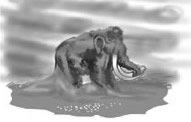
E
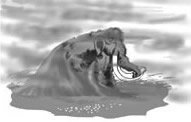
F

G

H
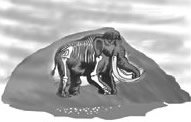
I

J
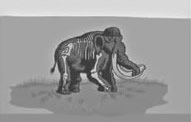
K
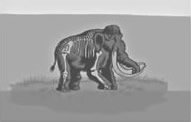
L
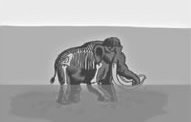
M
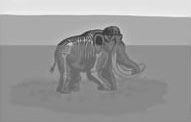
N
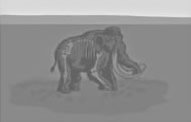
O
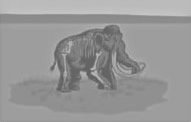
P

Figure 16.5. The mammoth is completely buried by a dust storm and breaks its front leg while trying to free itself, A to I. Further dust storms smooth the surface of the dust drift, J. Then water moves upward in the silt, J through N. The water and silt become permafrost, O, and then the permafrost faults, P, further breaking bones in the mammoth. (Drawn by Dan Lietha of AiG.)
We can safely eliminate man and trampling in a Siberian dust storm. That leaves the first explanation. Mammoths standing against an unusually severe dust storm would find themselves mired in very deep loess. If they had not yet suffocated they would try valiantly to extricate themselves. The torsional stress could break limbs, especially the more mobile front limbs.
In summary, Figure 16.5 presents a series of illustrations summarizing the carcass puzzles.
Mass extinctions at the end of the Ice Age
By the end of the Ice Age, the woolly mammoths had disappeared from Siberia. The woolly mammoth also went extinct over the whole Northern Hemisphere (see figure 14.6 for a time-line of the woolly mammoths from the end of the Flood to the end of the Ice Age). Agenbroad and Nelson74 state: “Why did mammoths disappear from Earth? This question remains one of the great unsolved mysteries of all time.”
Most of the other large mammals also became extinct or died off on whole continents at the end of the Ice Age. For instance, horses and camels of the Ice Age in North America disappeared, but survived on other continents. Horses were introduced in recent times by Europeans. Such mass extinctions are especially perplexing to uniformitarian scientists, and there is much controversy over the cause, as outlined in chapter 5.
A multitude of remains prove woolly mammoths and other animals had thrived and migrated over the entire Northern Hemisphere at the beginning of the Ice Age. The climate was equable (little change between winter and summer) and the plants and animals represented a mix of different climatic types. The post-Flood Ice Age model can explain not only the disharmonious mixing of animals, but also the dramatic climate changes that brought their demise.
The animals were accustomed to mild winters for most of the Ice Age. When the cold came at the end, they likely were not prepared. They would have required extra food to keep themselves warm. In addition to suffering from the cold, the ice sheets were melting and causing occasional superfloods. They also had to contend with gigantic dust storms, boggy ground from permafrost at the edge of the ice sheets, drought, grass fires, etc. The woolly mammoth and other large herbivores would be especially hard hit, partly because they required so much more food and water. They would be tottering on the edge of extinction within a short time. Carnivores and carrion birds would have their fill for a time, but as their food source died, it would be their turn to go extinct. The end-Ice Age mass extinctions were selective in that mainly large animals went extinct. The mass extinctions should really be called the extinction of the massive.75
There is abundant evidence of severe drought and giant dust storms after the zenith of the Ice Age. The severe dust storms were probably the major cause for all the extinctions in the Northern Hemisphere. (Drought likely was the major climatic culprit in the Southern Hemisphere.) Loess is rather common south of and within the periphery of the former ice sheets in the Northern Hemisphere. It forms a thick blanket in parts of central China.76 This was probably desert loess that blew in from the west. Unfortunately, it has not been recognized, yet, that large parts of Siberia are also covered with a layer of loess.77 In North America, we find large areas of stabilized sand dunes; for instance, extensive sand dunes cover areas of the Great Plains.78 The Nebraska sand hills blanket a large portion of western Nebraska and are up to 400 feet deep! Similar dunes are found north of the Cypress Hills in southeast Alberta and southwest Saskatchewan. Dunes are common in northern Europe and northwest Asia.79 Today, all of these dunes are mostly stabilized by vegetation. The dunes attest to the severity of the drought and dust storms during deglaciation. The climate in North America was so terrible that even camels and horses were driven to extinction! But other large mammals, such as elk, deer, and bison survived. It is not known why they survived while others went extinct. Could it be that elk, deer, and bison can live in more variable habitats, such as mountainous terrain with more moisture, while those that went extinct lived mainly on the plains?
Man, who had spread over the earth by this time (see chapter 13), was also stressed. Earlier he had found abundant game, but the climate change made hunting more difficult. Some have suggested that man caused the extinctions. It is questionable whether a hunting party could have taken down a large healthy mammoth with spears. Driving them off cliffs or into bogs would make more sense. When the animals were in a weakened state, they would have been easier to kill. Mammoths and other animals often were forced to congregate around scarce watering holes during end-Ice Age drought, as C. Vance Haynes80 and others believe. These watering holes would be ideal spots for man to hunt the mammoths.
So, man contributed a little to the extinction of the mammals. The climate change was the real culprit, by far. The minor role of man is supported by the relatively scarce association of mammoth remains with spear points, indicating there was no mass slaughter. Most researchers are unconvinced that man could have caused the extinctions in Siberia. There were far too many woolly mammoths, woolly rhinoceroses, horses, bison, and other animals for them to have had a significant effect.
Uniformitarian scientists do not see a unique climate at the end of the Ice Age as being the cause of multiple extinctions. This is primarily because of their stretched-out time scale. This has kept the mystery of end-Ice Age mass extinctions unsolved for over 200 years! By compressing the time scale into a 100- to 200-year period, the extensive sand and loess deposits over many areas of the world indicate a major disaster, far worse than the storms of the Dust Bowl era in the 1930s.
In conclusion, climate change at the end of the Ice Age was the main cause of late Ice Age extinctions. A post-Flood Ice Age explains why the large animals did not go extinct at the end of previous glaciations. There were no previous glaciations or interglacials. There was only one Ice Age, brought on by the unique conditions that followed the global Flood.
When we apply the Genesis flood and the biblical timetable to objective scientific evidence, confusion clears, mysteries are solved, and God is glorified.
Frozen in Time
Author Michael Oard gives plausible explanations of the seemingly unsolvable mysteries about the Ice Age and the woolly mammoths.
Read Online Buy BookFootnotes
- Oard, M.J., An Ice Age Caused By the Genesis Flood, Institute for Creation Research, El Cajon, CA, p. 132, 1990.
- Stone, R., Mammoth: The resurrection of an Ice Age giant, Perseus Publishing, Cambridge, MA, p. 100, 2001.
- Coffin, H.G., with R.H. Brown, Origin by design, Review and Herald Publishing Association, Washington, DC, pp. 256–267, 1983.
- Guthrie, R.D., Frozen fauna of the mammoth steppe — The story of Blue Babe, University of Chicago Press, Chicago, IL, pp. 30–34, 1990.
- Ibid., p. 15.
- Ukraintseva, V.V., Vegetation cover and environment of the “Mammoth Epoch” in Siberia, Mammoth Site of Hot Springs, South Dakota, Inc., Hot Springs, SD, 1993.
- Oard, M.J., The Missoula flood controversy and the Genesis flood, Monograph No. 13, Creation Research Society, Chino Valley, AZ, 2004.
- Baker, V.R., G. Benito and A.N. Rudoy, Paleohydrology of late Pleistocene superflooding Altay Mountains, Siberia, Science 259:348–350, 1993. Carling, P.A., Morphology, sedimentology, and palaeohydraulic significance of large gravel dunes, Altai Mountains, Siberia, Sedimentology 43:647–664, 1996.
- Vereshchagin, N.K. and S.V. Tomirdiaro, Taphonomic research in permafrost regions: A survey of past and present studies in the former Soviet Union; in: Mammoths and the mammoth fauna: Studies of an extinct ecosystem, G. Haynes, J. Klimowicz and J.W.F. Reumer (Eds.), Proceedings of the First International Mammoth Conference, Jaarbericht van Het Natuurmuseum, Rotterdam, p. 193, 1999. Agenbroad, L.D. and L. Nelson, Mammoths: Ice Age giants, Lerner Publications Company, Minneapolis, MN, pp. 57–58, 2002.
- Mangerud, J., J.I. Svendsen and V.I. Astakhov, Age and extent of the Barents and Kara ice sheets in Northern Russia, Boreas 28:66, 1999.
- Baker, V.R., Megafloods and glaciation; In: Late glacial and postglacial environmental changes — Quaternary, Carboniferous-Permian, and Proterozoic, I.P. Martini (Ed.), Oxford University Press, New York, p. 100, 1997. Svendsen, J.I., et al., Maximum extent of the Eurasian ice sheets in the Barents and Kara Sea region during the Weishselian, Boreas 28:234–242, 1999.
- Vereshchagin, N.K., The mammoth “cemeteries” of north-east Siberia, Polar Record 17(106):3–12, 1974.
- Vereshchagin, Mammoth "cemeteries", p. 5. Kaplina, T.N. and A.V. Lozhkin, Age and history of accumulation of the “ice complex” of the maritime lowlands of Yakutia; in: Late Quaternary environments of the Soviet Union, A.A. Velichko (Ed.), University of Minnesota Press, Minneapolis, MN, pp. 147–151, 1984.
- Guthrie, Frozen fauna.
- Fraser, T.A. and C.R. Burn, On the nature and origin of “muck” deposits in the Klondike area, Yukon Territory, Canadian Journal of Earth Sciences 34:1333, 1997.
- Vereshchagin, Mammoth "cemeteries", p. 6.
- Tomirdiaro, S.V., Evolution of lowland landscapes in Northeastern Asia during Late Quaternary time; in: Paleoecology of Beringia, D.M. Hopkins, J.V. Matthews Jr., C.E. Schweger and S.B. Young (Eds.), Academic Press, New York, p. 34, 1982.
- Hamilton, T.D., J.L. Craig and P.V. Sellman, The Fox permafrost tunnel: A late Quaternary geologic record in central Alaska, Geological Society of America Bulletin 100:950, 1988.
- Tomirdiaro, Evolution of lowland landscapes, pp. 29–37.
- Péwé, T.L., A. Journaux and R. Stuckenrath, Radiocarbon dates and late-Quaternary stratigraphy from Mamontova Gora, unglaciated central Yakutia, Siberia, U.S.S.R., Quaternary Research 8:51–63, 1977. Tomirdiaro, Evolution of lowland landscapes. Péwé, T.L. and A. Journaux, Origin and character of loess like silt in unglaciated south-central Yakutia, Siberia, U.S.S.R., Geological Survey Professional Paper 1262, United States Printing Office, Washington, DC, 1983. Pielou, E.C., After the Ice Age — The return of life to glaciated North America, University of Chicago Press, Chicago, IL, p. 151, 1991. Sher, A.V., Is there any real evidence for a huge shelf ice sheet in East Siberia? Quaternary International 28:39–40, 1995. Fraser and Burn, Nature and origin of "muck" deposits, pp. 1333–1344.
- Vereshchagin, N.K. and S.V. Tomirdiaro, Taphonomic research in permafrost regions: A survey of past and present studies in the former Soviet Union; in: Mammoths and the mammoth fauna: Studies of an extinct ecosystem, G. Haynes, J. Klimowicz and J.W.F. Reumer (Eds.), Proceedings of the First International Mammoth Conference, Jaarbericht van Het Natuurmuseum, Rotterdam, pp. 190–191, 1999.
- Guthrie, Frozen fauna, p. 53.
- Tomirdiaro, Evolution of lowland landscapes.
- Péwé, Journaux and Stuckenrath, Radiocarbon dates pp. 51–63. Péwé and Journaux, Origin and character, p. 20.
- Péwé and Journaux, Origin and character.
- Arkhipov, S.A., Environment and climate of Sartan maximum and late glacial in Siberia; in: Late glacial and postglacial environmental changes — Quaternary, Carboniferous-Permian, and Proterozoic, I.P. Martini (Ed.), Oxford University Press, New York, p. 56, 1997.
- Péwé and Journaux, Origin and character.
- Taber, S., Perennially frozen ground in Alaska: Its origin and history, Geological Society of America Bulletin 54:1473, 1943.
- Guthrie, Frozen fauna, pp. 53–58. Fraser and Burn, Nature and origin of “muck” deposits.
- Péwé, T.L., Quaternary geology of Alaska, U.S. Geological Survey Professional Paper 835, U.S. Government Printing Office, Washington, DC, pp. 34–43, 1975. Preece, S.J., J.A. Westgate, B.A. Stemper and T.L. Péwé, Tephrochronology of late Cenozoic loess at Fairbanks, central Alaska, Geological Society of America Bulletin 111:71, 1999.
- Walker, D.A. and K.R. Everett, Loess ecosystems of northern Alaska: Regional gradient and toposequence at Prudhoe Bay, Ecological Monographs 61:437–464, 1991.
- Hopkins, D.M., Aspects of the paleogeography of Beringia during the Late Pleistocene; in: Paleoecology of Beringia, D.M. Hopkins, J.V. Matthews Jr., C.E. Schweger and S.B. Young (Eds.), Academic Press, New York, pp. 18–19, 1982.
- Fraser and Burn, Nature and origin of “muck” deposits, pp. 1333–1344.
- Taber, Perennially forzen ground, pp. 1483–1484. Hamilton, Craig, and Sellman, Fox permafrost tunnel.
- Fraser and Burn, Nature and origin of “muck” deposits, p. 1342.
- Taber, Perennially forzen ground, pp. 1433–1548. Guthrie, Frozen fauna, pp. 19–22. Michel, F.A., The relationship of massive ground ice and the Late Pleistocene history of Northwest Siberia, Quaternary International 45/46:43–48, 1988.
- Washburn, A.L.,Geocryology: A survey of periglacial processes and environments, John Wiley & Sons, New York, p. 263, 1980.
- Walker and Everett, Loess ecosystems, p. 459.
- Wright Jr., H.E. and C.W. Barnosky, Introduction to the English edition; in: Late Quaternary environments of the Soviet Union, A.A. Velichko (Ed.), University of Minnesota Press, Minneapolis, MN, p. xvii, 1984.
- Taber, Perennially forzen ground, p. 61.
- Michel, F.A., The relationship of massive ground ice and the Late Pleistocene history of Northwest Siberia, Quaternary International 45/46:43–48, 1988.
- Mahaney, W.C., F.A. Michel, V.I. Solomatin and G. Hütt, Late Quaternary stratigraphy and soils of Gydan, Yamal and Taz Peninsulas, Northwestern Siberia, Palaeogeography, Palaeoclimatology, Palaeoecology 113:249–266, 1995.
- Guthrie, Frozen fauna, p. 71.
- Thiede, J., H. Kassens and L. Timokhov, Laptev Sea system discussed at Russian-German workshop, EOS 81(32):366, 2000.
- Oard, Ice Age Caused By the Genesis Flood, pp. 109–119.
- Ibid., pp. 46–49.
- Howorth, H.H., The Mammoth and the flood — An attempt to confront the theory of uniformity with the facts of recent geology, Sampson Low, Marston, Searle, & Rivington, London, p. 102, 1887. Reproduced by The Sourcebook Project, Glen Arm, Maryland. Schultz, C.B., The stratigraphic distribution of vertebrate fossils in Quaternary eolian deposits in the midcontinent region of North America; in: Loess and related eolian deposits of the world, C.B. Schultz and J.C. Frye (Eds.), University of Nebraska Press, Lincoln, NE, pp. 115–138, 1968. Vereshchagin, Mammoth "cemeteries", p. 6. Sutcliffe, A.J., On the tracks of Ice Age mammals, Harvard University Press, Cambridge, MA, p. 43, 1985.
- Zimov, S.A., V.I. Chuprynin, A.P. Oreshko, F.S. Chapin III, J.F. Reynolds and M.C. Chapin, Steppe-tundra transition: A herbivore-driven biome shift at the end of the Pleistocene, American Naturalist 146:775, 1995.
- Walker and Everett, Loess ecosystems.
- Walker, D.A. and K.R. Everett, Road dust and its environmental impact on Alaskan taiga and tundra, Arctic and Alpine Research 19:479–489, 1987.
- Walker, D.A. and K.R. Everett, Road dust and its environmental impact on Alaskan taiga and tundra, Arctic and Alpine Research 19:479–489, 1987.
- Zimov et al., Steppe-tundra transition, pp. 765–794.
- Sher, A.V., Problems of the last interglacial in Arctic Siberia, Quaternary International 10–12:219, 1991. Zimov et al., Steppe-tundra transition, p. 767. Fraser and Burn, Nature and origin of “muck” deposits, p. 1342.
- Ukraintseva, Vegetation cover and environment.
- Selby, M.J., Earth’s changing environment, Clarendon Press, Oxford, pp. 541–542, 1985.
- Guthrie, Frozen fauna, p. 221.
- Selby, Earth's changing environment, pp. 412–415.
- Soffer, O., The upper paleolithic of the Central Russian Plain, Academic Press, New York, p. 22, 1985.
- Sher, A.V., Late-Quaternary extinction of large mammals in northern Eurasia: A new look at the Siberian contribution; in: Past and future rapid environmental changes: The spatial and evolutionary responses of terrestrial biota, B. Huntley, W. Cramer, A.V. Morgan, H.C. Prentice and J.R.M. Allen (Eds.), Springer, New York, p. 327, 1997.
- Vereshchagin and Tomirdiaro, Taphonomic research, p. 188.
- Worster, D., Dust Bowl: The Southern Plains in the 1930s, Oxford University Press, New York, p. 22, 1979.
- Guthrie, Frozen fauna, p. 14.
- Farrand, W.R., Frozen mammoths, Science 137:450–452, 1962.
- Taber, Perennially forzen ground, p. 1489.
- Ibid., p. 1490.
- Ukraintseva, Vegetation cover and environment, p. 89.
- Guthrie, Frozen fauna, p. 78.
- Vereshchagin, Mammoth "cemeteries", p. 6.
- Ibid., p. 4.
- Vereshchagin and Tomirdiaro, Taphonomic research, p. 188.
- Sher, A.V., Is there any real evidence for a huge shelf ice sheet in East Siberia? Quaternary International 28:39, 1995.
- Pfizenmayer, E.W., Siberian man and mammoth, Blackie & Sons, London, p. 104, 1939.
- Agenbroad, L.D. and R.L. Laury, Geology, paleontology, paleohydrology, and sedimentology of a Quaternary mammoth site, Hot Springs, South Dakota: 1974–1979 excavations, National Geographic Society Reports 16:24, 1975.
- Agenbroad, L.D. and L. Nelson, Mammoths: Ice Age giants, Lerner Publications Company, Minneapolis, MN, p. 87, 2002.
- Stone, Mammoth, p. 102.
- Williams, M., D. Dunkerley, P. de Deckker, P. Kershaw and J. Chappell, Quaternary environments, second edition, Arnold Publishing, New York, p. 179, 1998.
- Ibid.
- Muhs, D.R. and V.T. Holliday, Evidence of active dune sand on the Great Plains in the 19th century from accounts of early explorers, Quaternary Research 43:198–208, 1995.
- Zeeberg, J., The European sand belt in eastern Europe — and comparison of Late Glacial dune orientation with GCM simulation results, Boreas 27:127–139, 1998.
- Haynes Jr., C.V., Geoarchaeological and paleohydrological evidence for a Clovis-age drought in North America and its bearing on extinction, Quaternary Research 35:438–450, 1991.
Recommended Resources

Answers in Genesis is an apologetics ministry, dedicated to helping Christians defend their faith and proclaim the good news of Jesus Christ.
- Customer Service 800.778.3390
- © 2025 Answers in Genesis

